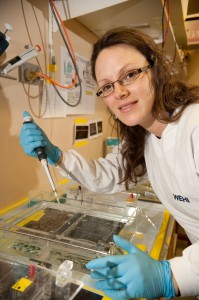Marnie Blewitt
The Walter & Eliza Hall Institute of Medical Research, Melbourne


Why are some plant seeds very small and others large? Angela Moles tackled this simple question by compiling information on 12,669 plant species. She discovered that plant seeds in the tropics are, on average, 300 times bigger than seeds in colder places like the northern coniferous forests. She then used these data to follow the evolutionary history of seed size over hundreds of millions of years.

The study was the first of its kind and the results, published in Science and PNAS, have revolutionised our understanding of the factors that determine the size of offspring in plants and animals. Angela is a leader in developing a new approach to ecology—one that could allow us to accurately model and predict the impact of climate change on ecosystems.
Continue reading Big ecology: From tundra to savanna
Erika Cretney is fascinated by the human immune system. “As we find out more about how it works, it seems to grow in complexity,” she says. “I’m not sure that we’ll ever know everything about it.”

Her interest lies in ferreting out the function of genes, proteins and cell types in the immune system, and identifying the roles they play. And with the help of her L’Oréal Australia For Women in Science Fellowship, she is pursuing a new target: a small group of T cells that play a role in controlling inflammation and auto-immune diseases.
The Fellowship will give her the freedom to promote her new field of study at international conferences and it will help with childcare costs as she balances a full-time research career with the needs of her young son. Continue reading Unravelling the immune system
Sarah Pryke has always had an eye for the shape, colour and movement of animals. After growing up surrounded by wildlife in a remote rural area of South Africa, she was employed as an illustrator by the local museum while studying for her science degree at the University of Natal.

Now, as a post-doctoral fellow of the at Macquarie University in Sydney, she is working in the Kimberleys investigating the impact of colour on the behaviour of the Gouldian finch, a small, dazzling bird of Australia’s tropical savannah.
With the help of her L’ORÉAL Australia For Women In Science Fellowship she plans to get a better understanding of their mating success – information that could be crucial to the survival of these endangered birds. Continue reading Life and love amongst the finches: Aggressive redheads win the best nest sites, but can the Gouldian finches survive?